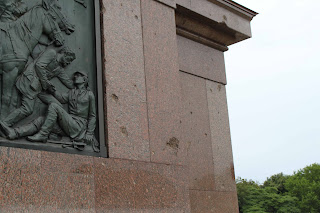The Victory Column was designed in 1864 to commemorate the Prussian victory over Denmark in the Danish-Prussian War. However, it was not completed and inaugurated until 1873, by which time the Prussians had defeated both Austria and France, and achieved the unification of all of Germany. This led to the change in the design of the monument to include cannons captured from each of the respective defeated nations on the first three of the four segments of sandstone.. Also, after the Franco-Prussian war, the statue of Victoria was added. Originally, the column stood in front of the Reichstag building.
 |
| Victory Column circa 1900 |
In 1938, Adolf Hitler and his personal architect Albert Speer made two decisions regarding the Column. The first decision was to relocate the column to its present location, 1500m from the proposed North-South axis of the New Berlin, exactly one Roman mile. The second decision was to add 7.5m to the overall height of the column, at the same time adding a golden garland ring to commemorate the end of the Battle for France. Also, Albert Speer designed the current system of four underground walkways that lead from the sidewalk under the street to the column, each sidewalk entrance covered by guardhouse-style shacks.
 |
| Bullet holes on the foundation |
In the occupation years of the city, the monument was saved by the British and Americans from the French, who wished to dynamite the monument. Also, the French took the metal fascades off the monument in 1945 to prevent the Germans from being reminded of the its former glory. These were eventually returned in 1987 for the 750th anniversary of Berlin, but some sections still remain in France.
Today, the Victory Column is one of Berlin's most famous sights, located a short way from the Brandenburg Gate and the Reichstag, as well as the Soviet War Memorial. It also acts as a reminder of how the spirit of Germany has survived its most traumatic experience in the history of the country. Until next time, take care, and thanks for reading.

No comments:
Post a Comment